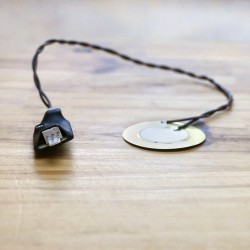












The piezoelectric sensor is used to detect impacts, vibrations or percussion. It senses the mecanical vibration transmitted through a material to which it is fixed. This is an analog sensor, meaning it perceives the difference between strong and weak impacts.
The piezoelectric disk is wired to an amplifying card which is adjustable by turning a small potentiometer.

Sensitive piezoelectric disks, alone, not soldered
The sensor's sensitivity is adjustable and thus can be adapted to many different contexts.

Our piezoelectric disks comme in two diameter sizes : 3,5 cm and 2 cm. Both sizes have equivalent sensitivity, but the size difference can be useful for equipping different surfaces and objects.
Piezoelectric vibration sensor with a 3,5 cm disk on the left, and a 2cm disk on the right :


"Piezoelectric Sensor" at Interface-z

Data returned by the sensor over time.
Comparison of different stretched wires – spiderweb at Interface-z
The sensor can be fixed to the floor and transmit the tremor made by walking nearby, or hidden under a table or a counter and react to the movement of a glass or some cutlery. It is usually used as a microphone, or to transform ordinary objects, into percussion instruments.
Not all materials conduct vibrations in the same way :
obviously musical percussion instruments (very hard wood, animal hide, copper) are good at transmitting vibrations, as well as hard plastics and metal. Wood absorbs and diminishes the vibrations quite a bit, and fabric reacts differently depending on how it is used. A tightly stretched rope or cloth can work well for vibrations, even though the lose material inherently doesn't transmit well.
The short video « Capteur Piézoélectrique » (by Lysandre Fournié) demonstrates an application example for a sound installation with piezoelectric sensors.
Derived from Jérôme Abel's original idea.
The piezoelectric sensor is changed into a sensitive strand : the disk must be properly fixed to a surface, a strand is attached to the disk and remains accessible. The audience or performer can then touch the strand wich returns the vibrations into the disk, instead of having to necessarily knock the surface as one would with the standard piezoelectric sensor.

Caution, it's not made for the strand to be pulled, for the fixtures upon the disk and the disks themselves are fragile.
The strand's length is around 20 cm.
The sensitive disk is fragile, as are the weldings which link it to the electronic board. One must not pull on the wires between the card and the disk. It is also unadvised to walk on the sensor, or try to bend or fold it.
It needs a good mecanical attachment to the material in order to properly perceive the vibrations through it : the fixture must be solid, a strong glue or a double-sided adhesive for example.
Avoid applying glue to the white part of the disk if you wish to reuse it in the future for something else.
Since Juin 2006, an extra disk is supplied with each sensor. If the weldings are torn off, one must exchange and solder the new disk with care, as to avoid overheating the white part of the disk. The weldings must not connect the white zone with the golden rim.
Reminder, do not forget to buy the sensor extension cords.
The raw data returned by the piezoelectric sensor often needs to be processed to be fully exploited. This type of data processing is transposed in various programming environments used by artists.
The piezoelectric sensor is typically associated with data stream peak detection, which lets one know the instant when the data peaks, and its maximum value, respectively matching the detected time of impact and its force.
Downloads :
- Processing and Max patchers + documentation
- Processing and Max patchers for piezoelectric sensors, with commentary
- Documentation on simple analog sensors
- Documentation on a few similar cards.
The demonstration video was made by Lysandre Fournié.
Piezolectric sensor by Interface-z on Vimeo.
